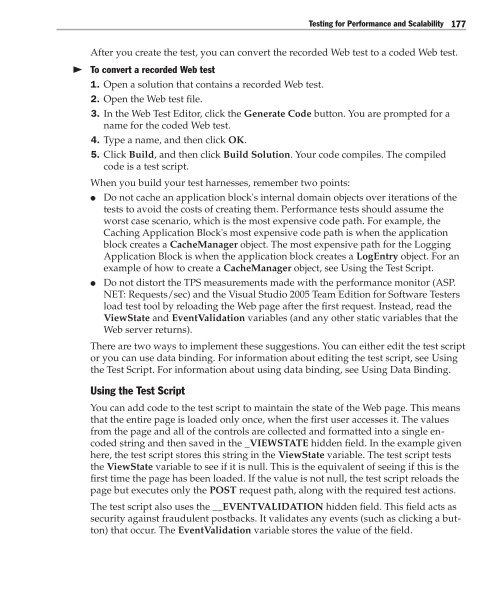Enterprise Library Test Guide - Willy .Net
Enterprise Library Test Guide - Willy .Net
Enterprise Library Test Guide - Willy .Net
Create successful ePaper yourself
Turn your PDF publications into a flip-book with our unique Google optimized e-Paper software.
<strong>Test</strong>ing for Performance and Scalability 177<br />
After you create the test, you can convert the recorded Web test to a coded Web test.<br />
<br />
To convert a recorded Web test<br />
1. Open a solution that contains a recorded Web test.<br />
2. Open the Web test file.<br />
3. In the Web <strong>Test</strong> Editor, click the Generate Code button. You are prompted for a<br />
name for the coded Web test.<br />
4. Type a name, and then click OK.<br />
5. Click Build, and then click Build Solution. Your code compiles. The compiled<br />
code is a test script.<br />
When you build your test harnesses, remember two points:<br />
●<br />
●<br />
Do not cache an application block's internal domain objects over iterations of the<br />
tests to avoid the costs of creating them. Performance tests should assume the<br />
worst case scenario, which is the most expensive code path. For example, the<br />
Caching Application Block's most expensive code path is when the application<br />
block creates a CacheManager object. The most expensive path for the Logging<br />
Application Block is when the application block creates a LogEntry object. For an<br />
example of how to create a CacheManager object, see Using the <strong>Test</strong> Script.<br />
Do not distort the TPS measurements made with the performance monitor (ASP.<br />
NET: Requests/sec) and the Visual Studio 2005 Team Edition for Software <strong>Test</strong>ers<br />
load test tool by reloading the Web page after the first request. Instead, read the<br />
ViewState and EventValidation variables (and any other static variables that the<br />
Web server returns).<br />
There are two ways to implement these suggestions. You can either edit the test script<br />
or you can use data binding. For information about editing the test script, see Using<br />
the <strong>Test</strong> Script. For information about using data binding, see Using Data Binding.<br />
Using the <strong>Test</strong> Script<br />
You can add code to the test script to maintain the state of the Web page. This means<br />
that the entire page is loaded only once, when the first user accesses it. The values<br />
from the page and all of the controls are collected and formatted into a single encoded<br />
string and then saved in the _VIEWSTATE hidden field. In the example given<br />
here, the test script stores this string in the ViewState variable. The test script tests<br />
the ViewState variable to see if it is null. This is the equivalent of seeing if this is the<br />
first time the page has been loaded. If the value is not null, the test script reloads the<br />
page but executes only the POST request path, along with the required test actions.<br />
The test script also uses the __EVENTVALIDATION hidden field. This field acts as<br />
security against fraudulent postbacks. It validates any events (such as clicking a button)<br />
that occur. The EventValidation variable stores the value of the field.

















